#hes starting a career in slapstick comedy
Explore tagged Tumblr posts
Text


I cant stop laughing at this clip of dewey taking this guy out
#HELP#just wrapping around his leg and flipping him over#hes starting a career in slapstick comedy#sorry the quality is TERRIBLE i was happening in a small corner of the screen 😭#connor dewar#toronto maple leafs#leafs lb#*
209 notes
·
View notes
Text
My Love Mix Up Episode 1
Let me start with some clarity on my perspective on this adaptation:
I have of course seen the Japanese live action Kieta Hatsukoi. It's not one of my personal favorites but it's a great show doing a very Japanese style of slapstick comedy.
I am going into this adaptation skeptical, same as I did for Cherry Magic Thailand (though that project completely won my heart and I ended up liking it more than the JBL, so my skepticism is by no means immovable). I am not opposed to this adaptation, but the pre-show content has not been promising.
I’ve been a fan of Fourth and Gemini in previous shows (Moonlight Chicken being their best work, IMO), but I have felt since they first started releasing teasers for this project that they are miscast in this and should have swapped roles.
So with that said, how was episode 1? It was fine! Not bad, not amazing, and pretty much what I expected. Some reactions:
I really like the actress playing Mudmee and think she has good chemistry with Fourth.
This first ep hit all the expected beats and inserted a couple things that are not in the source material, like the cat and the badminton plot. I am guessing that's mostly to add time, though personally I think the JBL’s choice with the dog who doesn't like Aoki is much more fun than the ~fated cat connection~ thing.
This version has toned down the zany energy of the original live action. I think that's for the best, as the slapstick moments that are still here are not hitting very well, but it does change the overall feel of it quite a bit.
AUNGPAO MY BELOVED. I'm excited to see him in another show and he looks flawless.
I stand by my belief that the main pair should have swapped roles. You can see them working hard to suppress their natural instincts in every scene. I don't blame the actors for this, they are still so early in their careers to be asked to act against type to this degree.
GMMTV is doing the same weird light filtering thing on this show that they did on 23.5. Why??? It makes the scenes look fuzzy.
This one definitely doesn't feel as revelatory to me as Cherry Magic Thailand's first episode did. With that one, right out of the gate I knew I was eating crow on my skepticism. I am not eating crow on this one yet; its execution is about at the level I expected and so far it hasn’t recalibrated the story to fit these actors and the Thai style as well as CMT did. But it’s still early so we’ll see how it progresses!
38 notes
·
View notes
Note
okay......anime. I'm sending a lot because I'm not entirely sure what you like? perhaps none of these? please ignore it as needed haha I am mainly getting it out of my system.
SERIOUS FARE - drama, action, adrenaline, feelings
Cowboy Bebop (1 Season, Complete) - slick, gritty, moody, jazzy, impeccably animated. neo-noir space-western about a crew of oddballs on a little spaceship just trying to get by. sometimes goofy, sometimes sad, always a favorite.
Chainsaw Man (1 Season So Far) - an impoverished, immature young man whose dreams include "eating some nice food" and "touching a girl" finds himself swept up in a career that allows him to do both those things and more, to varying degrees of satisfaction. also he can turn his body into chainsaws. it's coming-of-age it's horror it's action it's more found family it's good.
Violet Evergarden (1 Season, Complete) - some controversial choices were made for the adjacent movie, but the show is so good even standing alone. a traumatized child soldier slowly reconnects with her emotions by writing letters for other people. that's basically the whole story. made me cry a lot.
THE FUNNY PAGES - for when you need a laugh!
Spy x Family (1 Season, 2nd Incoming) - a delightful situational comedy set in Definitely Not Cold War Germany about a spy, his cover wife whom he does not know is an assassin, and his adopted daughter whom he does not know is a psychic. featuring moments of genuinely compelling found family connection.
Monthly Girls' Nozaki-kun (1 Season, Complete) - a girl summons the courage to confess to her crush. a series of misunderstandings ensues and doesn't stop ensuing. more mistaken identity goofiness, a cast full of charming dumbasses, and some insights into life as a manga artist. also another bangin theme song.
TOASTY'S TOP 3 - my absolute favorites
Vinland Saga (2 Seasons, 3rd Seemingly Confirmed) - you follow me so you are probably at least aware of this and whether it looks like something you'd enjoy but I have to include it. a viking-era tale of trauma, war, revenge, redemption, masculinity, religion, politics, philosophy, and more! season one is the prologue, where the antagonist is (imo) the secret main character. season two answers the unmitigated violence of season one with the povs of normal working people who end up as collateral damage, and also pays off one of season one's earliest setups in a huge fantastic way imo. it's idealistic without ever failing to acknowledge the pain that comes when idealism meets reality. I love it.
Run With the Wind (2 Seasons, Complete) - there aren't a whole lot of sports anime for older audiences, but this is one of them and I rewatch it on a yearly basis. you have to kind of slow yourself down for it--most shonen sports anime are brisk, high-octane fun-times, but this one (a college-age series about the most Underdog of Underdog Track Teams) really takes its time building up the characters and environment, and chemistry between the dual opposites-attract leads is so heartwrenchingly beautiful. they complete each other! they love each other! what does it mean to run? why do we run even if we know we can't win?! the answers to these things are found within each other!!
Mob Psycho 100 (3 Seasons, Complete) -slapstick, drama, mindblowing action scenes--this is another one that needs a little time to start showing you what it is, but there's so much heart in this dang show. a hymn to all things mundane and ordinary, a rumination on the dangers of suppressing one's emotions, a story about a middle schooler who tries not to use his Unlimited Psychic Powers and a fraud exorcist who pretends to have powers but doesn't. absolutely worth the watch.
BONUS LIGHTNING ROUND
Shirobako (a stressfully/excellently accurate anime about the anime industry, the only cute-girls-doing-cute-things show I like), Keep Your Hands off Eizouken (weird girls making amateur anime in high school), Blue Period (for if you want to have an existential crisis about ART), Kaiji (Squid Game before Squid Game), The Great Pretenders (Robin Hood-ass confidence artists pulling off HEISTS), Haikyuu (my favorite younger-audiences sports anime, get hype for VOLLEYBALL), Beastars (the Furry One, gorgeous 3d animation, dark and weird and wild), and Neon Genesis Evangelion (surreal horror sci-fi/fantasy, "mechs" vs. apocalyptic "angels", I haven't seen it but it's a standard and also I've been told not to watch it while depressed)
ANYWAY thanks for receiving this absolute infodump, do what you will with it!!
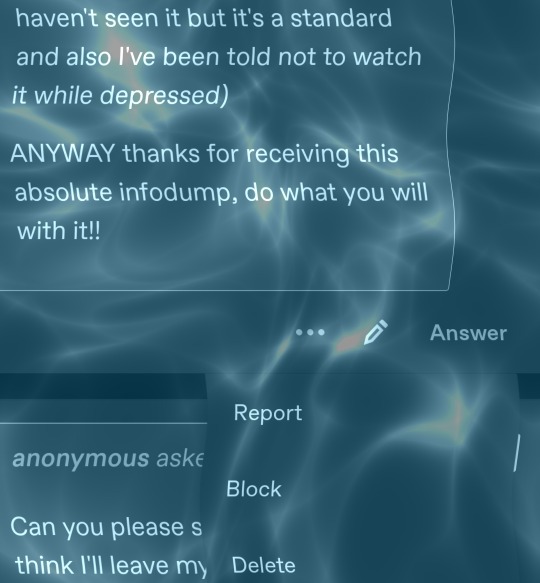
okay but honestly i didn't know cowboy bebop was one and done, i can commit to that
20 notes
·
View notes
Text
Top 10 Looney Tunes Characters

This year is truly an auspicious one indeed. It marks the centenary of not one, but TWO of the greatest film and animation studios that have ever been. One of them, as many are doubtless aware by now, is Disney, and I do have some things planned for later this year to celebrate that. However, another studio that’s been getting less attention than I think it deserves for its own 100th Anniversary is Warner Bros.! WB started the same year as the Disney studio, and they’re still going strong. When one thinks of WB Animation, chances are good the first characters and cartoons that come to mind are the Looney Tunes. These cartoon classics were a staple of theatrical animation from the 1930s all the way into the early 1960s…and since those days, the characters have continued to pop up in all sorts of places. Movies, TV shows, video games, comics…you name it, the Looney Tunes have been there. These toons are some of the most recognizable characters in the history of animation, more than on par with Mickey Mouse and his allies, and I’ve always loved them. So, I decided it was time to pay them proper tribute! With that said, what better way than to talk about some of my personal favorites? That’s what we’re here to do today. So let’s waste no more time! Mind you don’t slip on any banana peels or similar slapstick cliches: here are My Top 10 Looney Tunes Characters!
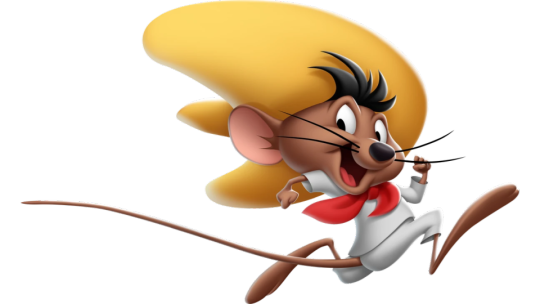
10. Speedy Gonzales.
Speedy is one of a few Looney Tunes characters who has sort of faced some controversy over his career (I refer you to Pepe Le Pew, for example). Some people have complained he’s a negative stereotype, but thankfully, the majority of people seem to really love the character. I think the reason why so many love him is because Speedy is one of the most positive and genuinely good characters in the Looney Tunes canon: he’s a character whose able to be heroic while also genuinely being really funny and interesting to watch. The self-proclaimed Fastest Mouse in All Mexico loves to race, loves to play, and isn’t afraid to shoot down the absurdity of some of his more bonkers co-stars, just as he isn’t afraid to outrun and outsmart any cat that tries to harm him or his friends. He’s a lot of fun himself, and he loves to have fun, and that’s probably the best type of cartoon hero there can be.
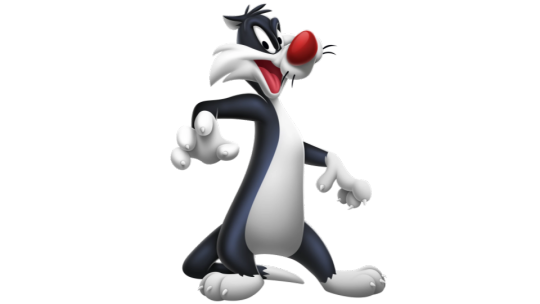
9. Sylvester the Cat.
Sylvester is one of several characters on this list notable for his sheer versatility. Most of his cartoons do focus on the same basic setup, mind you: Sylvester is hungry, and trying to catch something to eat…but inevitably gets foiled at every turn. Sometimes his prey is the aforementioned Speedy, who - in Coyote-and-Road-Runner-esque fashion - Sylvester is just never quick enough to slow down. He’s also occasionally gone after a kangaroo named Hippety Hopper, whom Sylvester somehow keeps mistaking for an oversized rat. (My comments on him “not being quick” stand here, too.) Most famously, of course, he’s the “Bad Ol’ Puddy Tat” constantly trying to gobble up Tweety Bird…who you will NOT be seeing on this countdown. (I’ve never actually liked Tweety, save for a few appearances. I WANT that super-cutesy little PSYCHOPATH to be cat food someday, and I don’t care how heartless that makes me sound.) While all of these did follow some similar patterns and formulas, each of these opponents offered a different kind of conflict for Sylvester to overcome, and therefore a different set of gags that could be utilized, and a lot of different scenarios to allow for comedy to happen. He also popped up in a few cartoons with Porky Pig, which brought a new dimension to the character: in these appearances, a mute Sylvester is depicted as Porky’s pet cat, who constantly has to save his oblivious master from all sorts of dangerous situations. Whether he’s a well-meaning scaredy cat or a greedy predator, he’s always fun to watch.
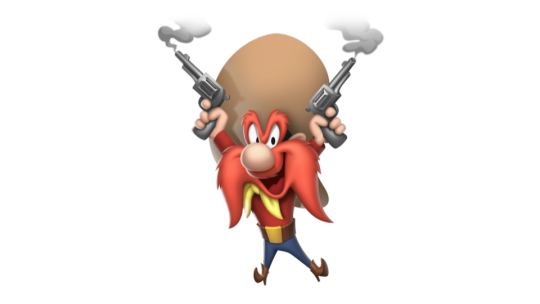
8. Yosemite Sam.
One of the most renowned villains in the Looney Tunes catalogue. I like to think of this loudmouthed little cowpuncher as the WB equivalent to Disney’s Pete. Both are characters who are versatile in how they have been fitted into just about every sort of time period and setting imaginable, with just about every antagonistic role you can think of. He’s most famous as being a Wild West outlaw, naturally, but Sam has also played a Black Knight, a Hessian Soldier, a Space Invader, a Crooked Politician, a Pirate, a Prison Guard, and many, MANY other things. Each time, his personality is the same: wild, hysterical, ornery, scheming yet somehow gullible, and eternally frustrated, usually due to the efforts of “that lowdown, long-eared, carrot-eatin’ varmint,” Bugs Bunny. Sam’s personality is just such an easy one to handle, and so fun to play with, you can put him into just about any type of situation, and without needing to change him much, he can work just as easily. I actually feel really bad placing him so low on the list, but hopefully those above him won’t disappoint.

7. Elmer Fudd.
Elmer is another character, sort of like Sylvester, who can play either protagonist or antagonist just as easily as the other. In fact, he’s been both more often than Sylvester has! We know him best, of course, for his many attempts to hunt down Bugs Bunny (and Daffy Duck), and these stories already have plenty of fun reinventions, twists, and overall moments. Everything from putting Elmer in different time periods (like the Stone Age), throwing him into different settings (like chasing Bugs into an opera house), or just changing up his role in some crazy way (like making him a viking with a magic helmet). No matter what you do, these always end the same for Elmer: either he never gets Bugs, or he THINKS he does, and then immediately regrets it because he’s just too softhearted and slow-witted for his own good. However, Elmer’s played other parts as well: sometimes he’s not even hunting Bugs, he’s just the victim of that “Wascawwy Wabbit’s” cruel pranks. Sometimes he’s just trying to get by, and Daffy Duck starts causing chaos for him. Poor Elmer just can’t catch a break, and that’s kind of why we like him: even when he IS the bad guy, he’s far from the WORST guy. Add to that his iconic voice and mannerisms, and it’s no wonder he remains one of the most recognizable characters in this group.

6. Porky Pig.
Believe it or not, Porky was the first real superstar character in the Looney Tunes library. That’s one of the reasons the classic ending line we all know and love was given to him (it’s also why Bugs would later take it over a couple of times, when HE became a star). Much like Yosemite Sam, Porky is one of the most versatile characters on the team, but in a different way: while Sam is a versatile antagonist, Porky is a versatile protagonist. Porky is essentially the straight man to all the other totally bonkers toons around him. He’s sort of the Kermit the Frog of this universe: a guy constantly trying to keep his cool and be civil, but forever aggravated and tormented by the world around him. With that said, the way he bounces off different characters already has a lot of different ways of working: his most famous co-star is probably Daffy Duck, and even just with that one character, they’ve had a relationship that has gone in just about every direction it can go. Sometimes Porky is Daffy’s sidekick, who always proves to be more competent and level-headed than the vain and over-the-top Daffy could ever hope to be. Other times, Daffy is actually HIS sidekick, forever frustrating Porky with his goofy antics. And still other times, there’s no “sidekicking” involved, Daffy just…kind of shows up to totally ANNOY the pig until Porky inevitably snaps and goes berserk. Even Porky cartoons that don’t involve Daffy (and there are plenty of those) usually follow one of these three patterns: Porky is eternally an Alice in the Wonderland of the Looney Tunes…you know, if Alice had a stutter. And was a pig. And was no longer female-okay, that analogy didn’t work, but you get the idea.

5. Taz.
Taz, a.k.a. The Tasmanian Devil, is a rare example of a character whose star has risen over time since his initial appearances in the Golden Age of the Looney Tunes. Back then, Taz only showed up in five cartoons, between 1954 and 1964; the twilight decade, many would say, of these great cartoon stars. No one would have likely guessed that Taz would take off to become one of the most iconic and popular characters in the Looney library, with tons of merchandise, a TV show with him as the main protagonist, several major video game and film appearances, and so on. For some reason, however, this wild, ravenous, spinning-and-slobbering devil just kept being used, and the public kept eating him up just as fast as he ate…well…EVERYTHING up. He went from a pure villain who would devour anyone in sight, to suddenly becoming a slightly more heroic, albeit not always terribly bright, character. He can, could, would, and WILL just as easily play the role of an ally to characters like Bugs and Daffy, as much as their adversary. It’s hard to say exactly why Taz caught on, but I’m certainly not complaining about it, since he’s a ton of fun to watch every time. And again, that’s really all a great cartoon star needs to be. (Also, for anybody who may be curious...I do have a mild crush on this guy. I’m weird, shush.)
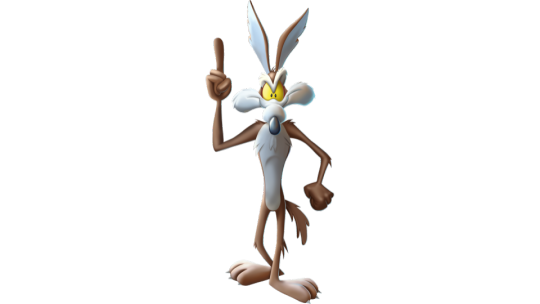
4. Wile E. Coyote.
It was actually really hard for me to choose between Taz and the Coyote, and I’m not honestly entirely sure if I made the right choice. It was essentially a tie between the two characters; on any given day, my mind could change. But, in the moment of making this list, I felt Wile E. deserved slightly higher placement, and thus here we are. (Also, yes, much like Taz, I do have a mild crush on the Coyote. Again, I’m weird, shush.) Having said all that, I imagine this self-proclaimed Super-Genius hardly needs an introduction. Much like Sylvester, Wile E. mostly spends his time trying to get something to eat. Usually, he’s found chasing the Road Runner and trying to trap him, but on a couple of occasions he’s bedeviled Bugs Bunny, and once in a blue moon he’ll have encounters with other characters. In most of Wile E.’s appearances, he’s a silent character, communicating solely through body language, facial expressions, and the occasional random sign he pulls out of nowhere. Whenever he DOES speak, he speaks in a smooth, slick, uppercrust English or Mid-Atlantic dialect. Whether silent or speaking, this Coyote’s basic trouble is always the same: despite his own confidence in his supposed superior intellect, a combination of clumsiness, shortsightedness, and his bizarre obsession with relying almost entirely on the ACME Corporation’s clearly faulty products always leads to him getting bamboozled. Over time, animators, writers, and directors have found new ways to spin off of Coyote’s usual formula, with stories like him taking the Road Runner to court, or turning into a fat slob due to an over-reliance on his own inventions. It’s the bizarre blend of brilliance and determination against poor planning and overconfidence that makes him such a fun character to see in action. He may never win…but I think a lot of us wish he could.
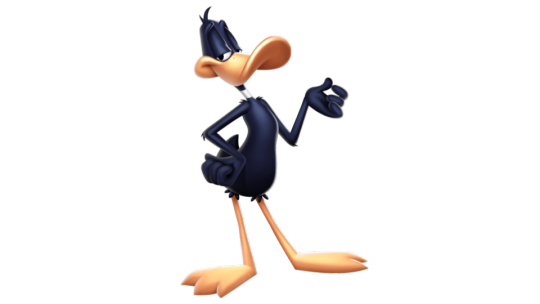
3. Daffy Duck.
While Porky was the first superstar character among the Looney Tunes (and Merrie Melodies), Daffy was really the first breakthrough character that was TRULY befitting of the title “looney.” In the early days, Daffy was a wisecracking, wild character, zipping about and causing trouble; a constant trickster who was a bundle of energy, causing mayhem for various hapless boobs. Most of the characters who followed suit on this idea - including his future rival, Bugs Bunny - essentially took their cues from Daffy’s book. Over time, the character crystalized into the mad mallard we know today. Daffy is still zany, but what he’s most known for today is his ego. Daffy is practically a narcissist, selfish in just about every way, as well as frequently quite greedy. Everything he does is for either the spotlight, cash, or both. He’s yet another character who has been the villain just as often as he’s been the hero…but even when in a more protagonistic role, he’s ALWAYS a flawed character, whose self-serving attitude leads to disaster for himself, and usually for many others. Just like Yosemite Sam, he’s also a character who has played many roles: any time the Looney Tunes want to parody a particular genre, it seems like Daffy is always the character who gets chosen. Whether he’s imitating Robin Hood or Sherlock Holmes, or going on high-flying escapades as the incompetent space hero called Duck Dodgers, you can go on a lot of different adventures with him. He’s been partnered up and pitted against nearly every character on the crew, and each and every alliance, rivalry, and so on is fun to see in action.

2. Bugs Bunny.
Just as it was hard to choose between Taz and Wile E. Coyote, it was also hard to choose between Bugs Bunny and Daffy Duck. In the end though…maybe it’s too predictable, but I ultimately did feel I preferred Bugs SLIGHTLY over Daffy. What’s interesting is that, in the early days, Bugs was pretty similar to Daffy: in a lot of his earliest appearances, they’re almost the same character. Both were madcap tricksters who seemed to exist just to drive other characters completely insane for the sheer sake of it, and both had big egos that needed to be satisfied. (In Bugs’ case, this was most evident in encounters he had with the character Cecil Tortoise, who might be the only character in all of Looney Tunes to truly outmatch Bugs on the cartoon battlefield, over and over again.) Over time, however - mostly thanks to Friz Freleng and Chuck Jones - Bugs began to evolve. While still a trickster with a wild sense of humor, the character became more laid back, casual, collected. He was someone who went into situations with the confidence that he could come out okay, if he just thought fast and didn’t let it all faze him. And while he could be downright cruel in the ways he would trick and toy with people, the attacks became unprovoked less often: it was usually a case of others doing something wrong to Bugs, and he would finally lose patience and declare, “Of course you realize THIS means war.” That’s essentially the Bugs Bunny we know today: he still faces conflict and such, but it’s his approach and the way he reacts to situations that makes him such fun to watch. Once again, it also makes him quite versatile, as he can be anywhere and play just about any role, from the star of the show to more of a narrator or similarly peripheral character. He can be the everyman, the superman, and as long as it always sticks to the traits he started out with, it will always work. In fact, the only real question about his placement on this list is…why isn’t he number one?
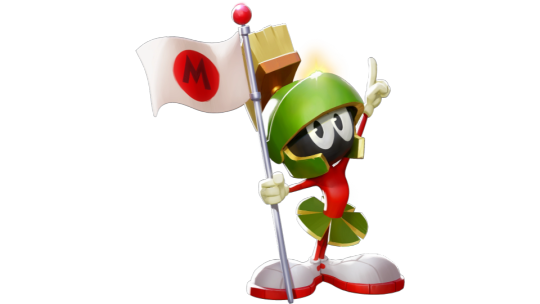
1. Marvin the Martian.
I don’t know WHY Marvin is my favorite Looney Tunes character, but he is, and really always has been. He’s not by any means the funniest of the Looney Tunes, but there’s something about this little world-destroying gremlin I find endlessly endearing. Much like Taz, Marvin started out as a small fish in a big cartoon pond; in fact, just like the Tasmanian Devil, Marvin the Martian (originally called “Commander X2,” and later “Antwerp”) only showed up in five cartoons during the Golden Age of the Looney Tunes. He fought Bugs Bunny in four of them, and Daffy Duck and Porky Pig in another. And while he hasn’t become the merchandising mammoth that Taz has, he’s still got a very loyal fanbase and following, and has remained a mainstay among the Looney Tunes ever since. Just like Taz, creators just kept using him, and fans kept asking for more; somehow, this little martian never faded away. What I love about Marvin is that he’s essentially another straight man, much in the way Porky is…but now, he’s a straight man on the opposite side of the fence. He’s usually the bad guy, while Porky is almost always the protagonist: whether Marvin’s trying to abduct people, conquer worlds, or blow up the Earth (because it obstructs his view of Venus), he’s always an obstacle the other characters have to overcome. Yet he’s depicted as so loveable and so mild-mannered, it’s hard to be scared of him or dislike him. It also means the moments where his inner rage gets the better of him, and his temper flares, become all the more hilarious: seeing that pomposity and stiff-upper-lip nature get blown apart at the seams is always a ton of fun. It’s difficult to describe my reasoning, but regardless, Marvin the Martian will always be My Favorite Looney Tunes Character.
HONORABLE MENTIONS INCLUDE…
Foghorn Leghorn.
Michigan J. Frog.
Rocky & Mugsy.
Road Runner.
Lola Bunny.
Gossamer. “Th-The-The E-THAT’S ALL FOLKS!”
#list#countdown#top 10#best#favorites#characters#looney tunes#merrie melodies#cartoons#wb#warner bros.#looney toons#bugs bunny#daffy duck#marvin the martian#wile e. coyote#taz#porky pig#elmer fudd#yosemite sam#sylvester the cat#sylvester#speedy gonzales
38 notes
·
View notes
Text
Theatre Deep Dive: David Tennant in 'The Real Inspector Hound/Black Comedy' (1998)
For today's dig into DT's theatre career, let's have a chat about the 1998 double-billed plays The Real Inspector Hound and Black Comedy, shall we? They're a bit special because these were the plays which introduced David to Gregory Doran. Doran was at the director's helm for both.
I have the programmes for the play's Richmond Theatre and Comedy Theatre runs...oh, and just so you know, The Comedy Theatre is now called the Harold Pinter Theatre (the theatre where David did his production of Good.) Anyway, these two photos are the front cover and the cast list from my Comedy Theatre programme:

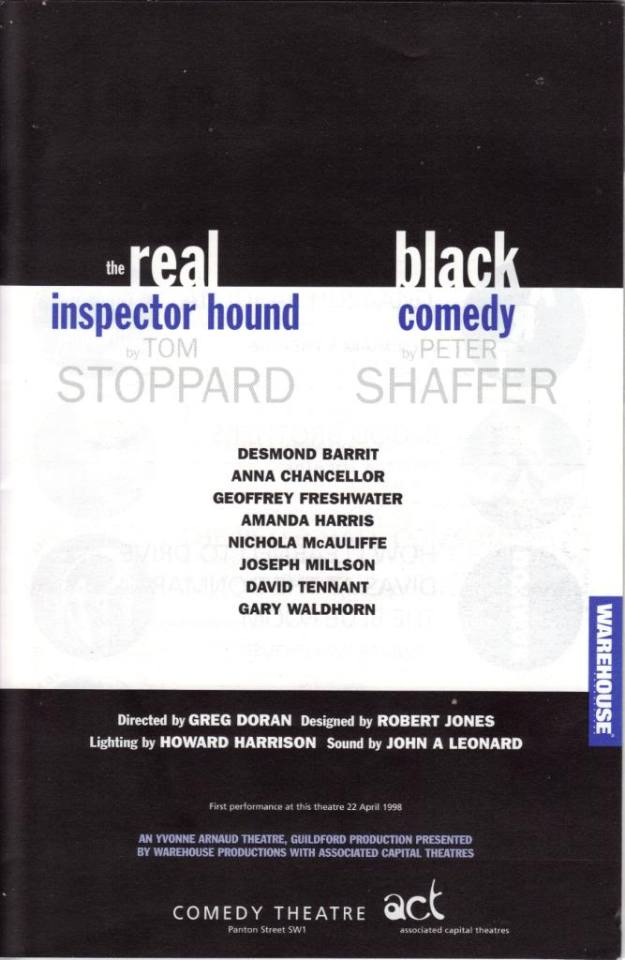
Programme: The Real Inspector Hound/Black Comedy, The Comedy Theatre
Sadly, I'm missing the programme for the production's run at the Yvonne Arnaud Theatre -- my hunt continues! -- but I do have the programme for the play's Richmond Theatre run. I find it fascinating as well as beneficial to collect the programmes for all parts of each production's run, since many of the programme details (including such things as cast lists and the works listed in each actor's biography) can change from venue to venue. To see this in action, here are the front cover and the cast list from my Richmond Theatre programme of the production:

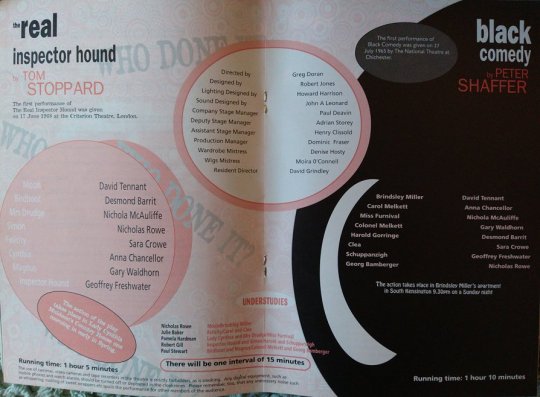
Programme: The Real Inspector Hound/Black Comedy, Richmond Theatre
Now back to the plays, and their particulars.
Peter Shaffer's Black Comedy and Tom Stoppard's The Real Inspector Hound were two one-act satirical plays from the 1960s with many similarities. Both were farcical and played off comic stereotypes: The Real Inspector Hound targeted theater critics and an Agatha Christie-style crime thriller, and Black Comedy aimed for one-dimensional "Clue"-like characters getting into trouble in slapstick physical comedy. Both also had five men and three women in the cast.
The production opened at the Yvonne Arnaud Theatre in Guildford for press night on 25 March 1998. It moved to the Richmond Theatre for a 7 April to 11 April 1998 run, and then to the Comedy Theatre (now the Harold Pinter) on 22 April 1998. At that venue it was extended from its initial end date of 11 July, and ran through 8 August 1998. The show ran 2 hrs and 40 minutes long: The Real Inspector Hound clocked in at 1 hr and 5 minutes, then a 20 min interval, and then Black Comedy ran 1 hr and 10 minutes.
Even though all the reviewers at the time went on and on and bloody ON about how these two plays had never been produced together, I've found that's not quite accurate. A production of the two plays was staged in 1996 by London's Millfield Theatre Company:

So to my knowledge, that's the only other time prior to Doran's production.
Anyway, Doran let the same set of actors play two different sets of comic stereotypes in two separate situations, and chose to keep both plays set in their original 1960s settings instead of bringing them into the present.
Now - on to the plays!
The first play of the evening, The Real Inspector Hound, saw David play a self-obsessed, downtrodden theatre critic named Moon. It's a play within a play - one is a parody of the Agatha Christie country-house type thriller, and the other a study in wish-fulfillment, showing how a couple of theatre critics are drawn inexorably into the play.
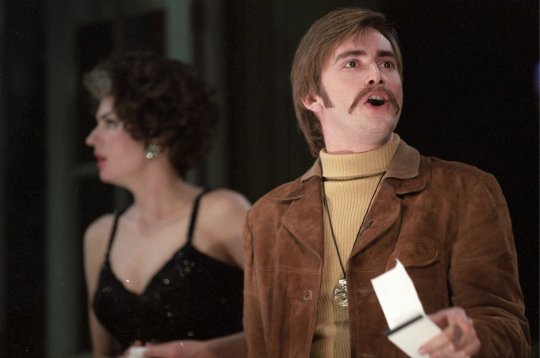

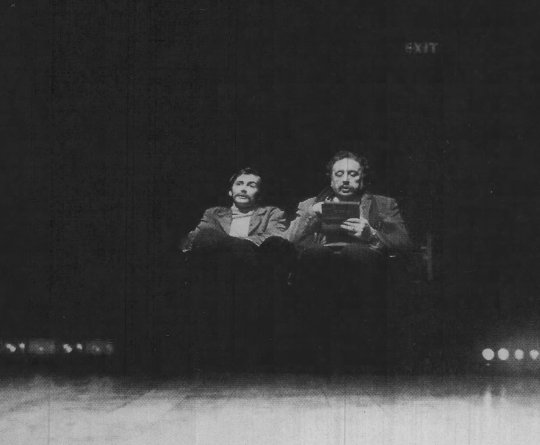
David Tennant as Moon in The Real Inspector Hound, 1998
Moon - along with his fellow critic Birdboot - start watching a country house thriller in order to review it. But Moon can't stop harboring murderous thoughts of his own. He's a second-rate critic, and he knows he'll never get out from under the shadow of the senior reviewer. Meanwhile, the thriller the two critics are watching starts unfolding in front of the audience's eyes, and Moon and Birdboot - who at the start of the play are behind the action - slowly keep moving towards its center. Stoppard takes the fantasy of wondering what it would be like to get up and join the action by breaking down the wall between stage and auditorium, following it through to a fatal piece of audience participation and a nightmarish conclusion.
Surreal!
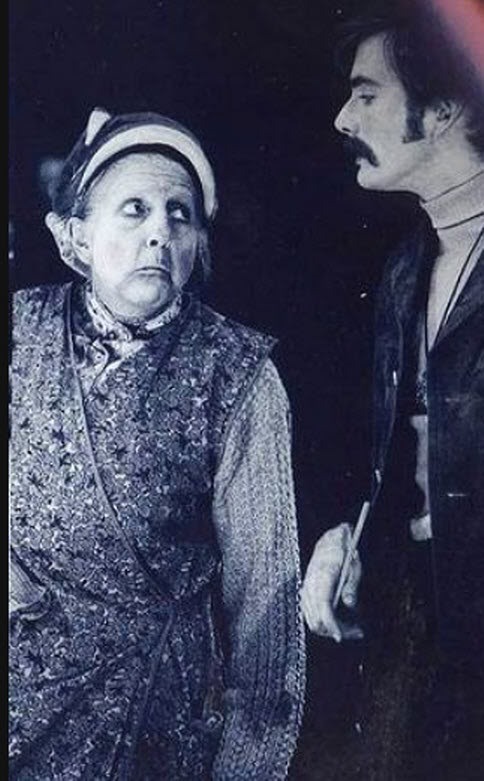
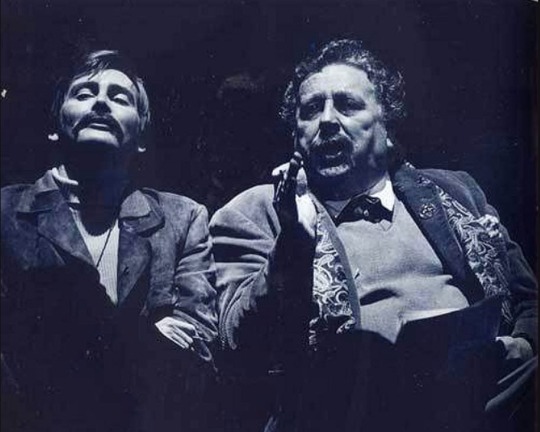
David Tennant as Moon in The Real Inspector Hound, 1998
Then came the interval, and afterwards came Black Comedy. Shaffer titled it after its clever and unique contrivance: the stage is fully lit to see characters when they're "in the dark," and the stage goes dark when the action is supposed to take place in normal light. So when the curtains open the stage is cloaked in darkness, and when the characters talk about a party they're about to give and then mention a blown fuse, the stage lights go on. But for the ~characters~ it's now dark, so they begin to fumble and feel their way about. Very clever indeed!
David played Brindsley Miller, a young beatnik sculptor living in a flat in South Kensington. Brindsley had "borrowed" a lot of posh art and furniture from a gay neighbor who'd went on holiday and placed it in his own flat in order to impress both the deaf German millionaire who wishes to look at his work and his fiancee Carol's father, the Colonel, who'll he'll be meeting for the first time. But Brindsley's web of deception begins to catch up to him when his neighbor returns home early and joins the party.
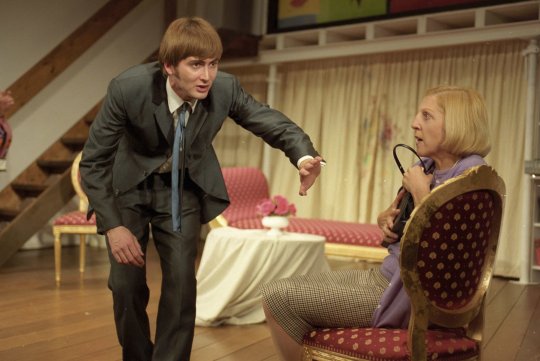
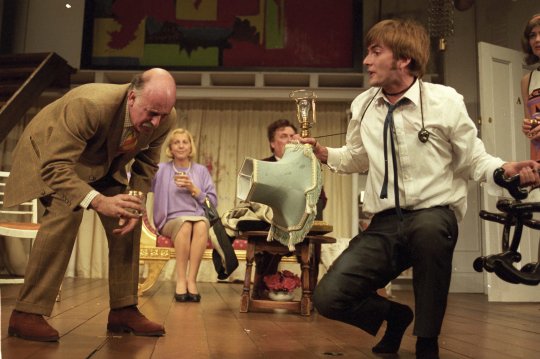
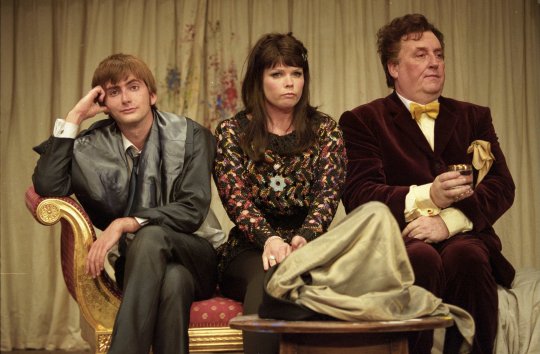
David Tennant as Brindsley in Black Comedy, 1998
Poor old Brindsley has to return everything he borrowed...without anyone knowing. In the dark! But then it gets worse. The longtime girlfriend Brindsley recently broke up with (but is still in love with) walks in. And his gay neighbor, Brindsley learns, is also in love with him! And soon a spinster drinking herself silly, a man from the electricity board, and the aforementioned deaf German millionaire join the party. And everyone is jealous. And there are a lot of tantrums.
And Brindsley gets his ear twisted.
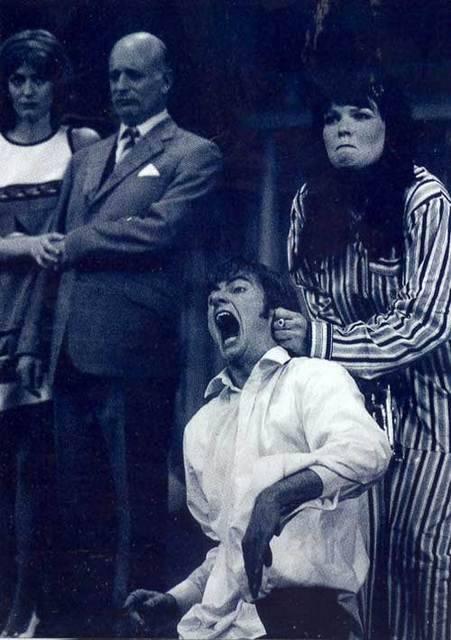
David Tennant as Brindsley in Black Comedy, 1998
David - and the plays - got a slew of positive reviews! Black Comedy's breakneck pacing, near-misses and pratfalls made it a perfect vehicle for David's athletic and comedic acting. For his role as Brindsley, David was called "for all the world a young Davy Jones in his two-tone suit."
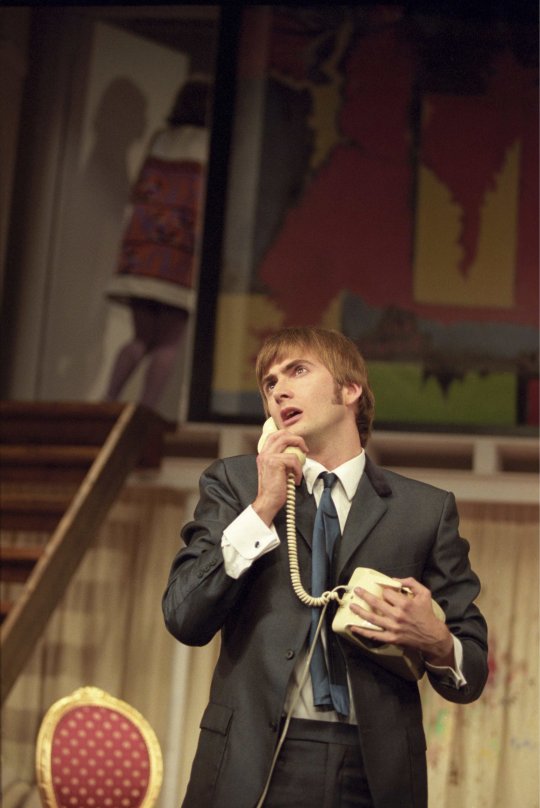
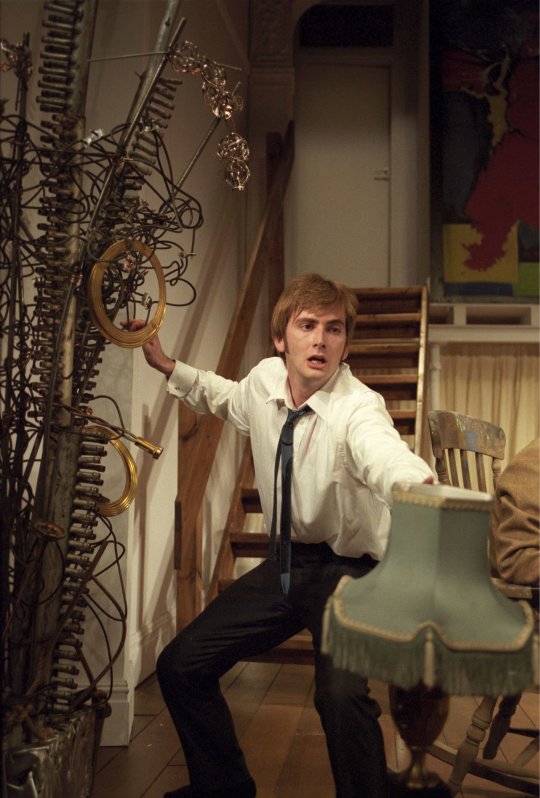
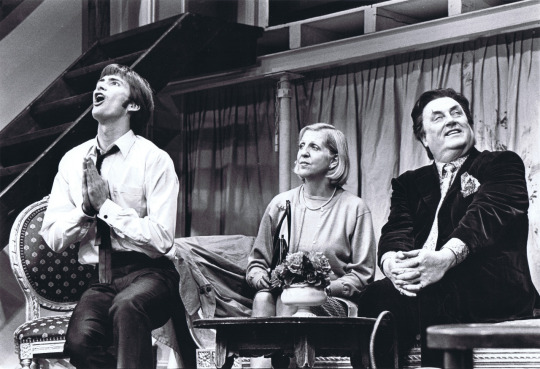
David Tennant as Brindsley in Black Comedy, 1998
Other reviewers said David had "all the sweaty desperation of the farceur," was "splendidly agile," and offered "a virtuoso demonstration of physical farce-playing." Yet another reviewer said, "No one works harder than David Tennant…this is inspired clowning as he fumbles his way about spreading confusion all around." And one even went so far as to say David was highly promising and "strongly recalled Michael Crawford, who played the role on Broadway, as the hapless and increasingly hysterical Brindsley."
For his role as Moon in The Real Inspector Hound, David was "particularly fine, all slumped angular embitterment as the aggrieved second-string critic." Another said the role was "beguilingly and plausibly played," and another that he "shin[ed] as the ever more deranged Moon."
I wish I could've seen these. As far as I know, no recordings of this production (video or audio) were ever made. *sigh*
And that, my friends, is a wrap!
18 notes
·
View notes
Text
After hearing about Oshi no Ko for months, I finally got around to watching season 1/reading up to the latest chapter of the manga,,, and,,, I think I went in with my expectations too high from how much it has been hyped? I enjoyed it, but it feels like a solid 6.5/10 for me
Rambling under the read more
The positive:
Love Ai, love Ruby, love Aqua. I particularly enjoyed how the first arc was set up, I enjoy how Aka has handled writing characters reacting to trauma differently, and I am enjoying the current arc.
Aqua and Ruby's relationship from being doctor/patient that considered each other to be family to being reborn as twin reincarnators to finding out who the other was in the previous life? chef's kiss
Ai on the other hand is honestly one of my absolute favorites and I honestly have no words to describe how much I love how she was written. I just love her,,, so much,,, ┗( T﹏T )┛
The negative:
The Akane - Aqua - Kana love triangle, the completely random interjections of slapstick comedy, the stage play arc, the random crow girl? All felt incredibly unnecessary/take away from the story line.
It honestly feels like Aka wrote the first two arcs and the current arc and then was told by his editor that he needed to fluff the story out. To an extent, I get that he is trying to show different dark parts of show biz/level up Aqua/Ruby's career path, but it just feels so?? Rushed?? Disjointed?? A slodge to read through at times?? Like Aka couldn't decide if he wanted to write a murder mystery, a high school romance, a rise in showbiz, or a comedy, so he spins a wheel every chapter and what it lands on is what that chapter is going to have.
Kana had this fantastic character journey with starting at her lowest point in her career, to starting to realize it's ok to let her acting shine again in the shojo live action, to really starting to really shine on stage/regain her confidence as an idol?? And then comes the stage arc to reset her to zero and go through the entire character development in three panels?? And she leaves the idol group after barely being shown in it??
How the entire idol group is handled??? Is just so weird to me like they were shown on stage one (1) time and they got one (1) MV, and then the group just pretty much just?? gets shoved to the background?? Why wasn't Ruby allowed to go out and recruit members? Why was her showbiz career pretty much just a quick montage?? Why do we see Aqua interacting with the girls more than they do with each other????????? Why is Ruby rarely allowed to interact with anyone without Aqua having to introduce her to them/being the object of their discussion????
I'm just,, not happy with how the idol group was handled in general. I would have loved for the story to focus 50% on Aqua trying to find the killer and 50% on Ruby progressing through her idol career instead of focusing 90% on everyone falling in love with Aqua while he has internal monologues in the corner :| It would have been so so so much fun to see Aqua going a progressively darker route with his manipulations as a foil to his sister who is steadfast in her refusing to lie/go against her morals/actively trying to heal, but still trying to seek justice for her loved ones??
IDK and how the hunt for Aqua/Ruby's dad is being handled is kind of weird? Their dad is a serial killer, but it feels like it was forgotten about for half the series? Like Aqua realizes the killer is probably his dad, but all we are shown (outside of Aqua's thoughts) is one panel per arc showing the completed paternity tests? Like why do we never get to see Aqua in action collecting the samples, making small talk with the crew to try to find clues? Why are there no panels with reporters talking in the background about actresses going missing? If Hikaru really has been killing for what? 20ish years? (Age 11 to 33?), and his primary targets are celebrity women at the peak of their career?? Shouldn't more people?? Notice?? The very famous women missing??? Isn't this something internet forums would be eating up???? Wouldn't Miyako be reminding the girls constantly about safety if she knew celebrity women were going missing? Wouldn't she be implementing safety precautions? Why do we only find out about celebrity deaths out of nowhere?
Like Ai and Gorou's murders were really well done, but the way we find out that Taiki's parents died in a murder/suicide is just by Taiki flat out saying it? Why wasn't that mentioned earlier instead of him just telling Aqua at the very end of that stage play arc? Aqua would have absolutely seen it on the news when it happened or at the very least heard from the director he is studying under?? The crew would have been gossiping about it on set for sure??? With how big of otaku Kana and Akane are about acting, they would have known that from the get go/mentioned it to Aqua when they found out they were acting alongside Taiki?? It's kind of a big elephant in the room and somehow nobody mentions it?? Idk I felt like there could have been just much more suspense/foreshadowing of all the murders/setting up their dad as the big bad, but love triangles and slapstick comedy were the priority (╯°□°)╯︵ ┻━┻
#oshi no ko#spoilers#both negative and positive rambling#ruby deserves better#akane and kana have 10000% better chemistry as a couple with each other than with Aqua
12 notes
·
View notes
Note
Since I asked for modern Disney TVA I'm gonna ask for Cartoon Network too (but obviously splitting it up instead of every show at once). Who is your favorite character from each of the 90s half of the Cartoon Cartoons-era shows you've seen like: Dexter's Lab, Johnny Bravo, Cow & Chicken, I Am Weasel, The Powerpuff Girls 1998, Ed Edd n Eddy, Mike Lu and Og, and Courage the Cowardly Dog?
I appricate that as there are a lot. But I'm also happy to talk about these and almost all need a rewatch from me (Ed Edd N eddy is the exception not due to quality but due to my top 25 episodes list, i've seen most of the ones i'd want to rewatch)
Dexter's Lab: An awesome show and one close to my heart. It has a few eps that are a bit too mean spirited for it's own good (a trait that most of these shows share, it's a common problem in children's comedy), but overall is just a fun show with a simple but effective premise. It also has Phil Hartman in one of his final and best rolls as Dexter's dad, so that's a bonus. I do feel the film and revivial seasons aren't as good, with Dial M For Monster being a better finale, but overall the series is a nostalgic classic to me.
Edit: So yeah turns out I was wrong. It was Jeff Bennet. I just always asumed phil hartman was his dad and that's why it was canceld. A good reminder to always check an assumption you had when you were 8.
Johnny Bravo: your timing on this one is good as I got the season 1 dvd on a whim a few weeks back at walmart and while I need to watch more of it, what i've refreshed is great. For a show about a wannabe pickup artist, the show's aged remarkably well: most of the violence against johnny is too slapstick to be a double standard and Johnny is more a clueless man child than actual threat to any woman and gets brushed off or outright punished when he does his cheesy pickup routine. Not only that but the humor.. is delightfully nuts. You've got episodes where Johnny dates an antelope, thinks time has stopped and in a faviorite bit of mine no one talks about gets a career in the moving pictures cumilating in the beloved classic
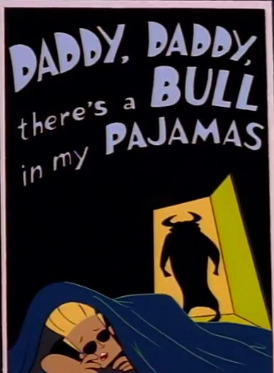
Cow and Chicken: This one.. yeah I have some nice things to say. The designs are nicely grungy, the theme song's a banger and it uh.. yeah that's about it. This one's a sadist show with Chicken sometimes getting punished for doing genuinely bad stuffa nd often getting punished for existing. It's far from the worst cartoon i've seen but is entirely not for me. Again except the theme song, and even then it's in an era of outright banger theme songs
I Am Wesel: This show .. is okay. The segments on cow and chicken were the highlight and while the show does lap into those sadist show tendicies I mentioned for cartoons in general it' snot nearly AS consitent with it as it's sister show and Weasel and Baboon are just fun to watch with great voice work. Weasel in paticular is just awesome. Solid show.
The Powerpuff Girls: one of cn's best shows and one of the ones i've rewatched more as my niece was really into it years ago. It has a sweet vibe to it at it's best, creative villians, some of the best voice actors there ever were in character defining rolls, and some solid aseops other shows weren't doing like how cops can be assholes and feminism can be complicated. Like i'm starting to realize ALL of these it once again has episodes that are just unwatchably mean, seriously I wasn't wrong when I said it was a common problem, but the bulk of the show is just a joy to behold.
Ed, Edd N Eddy: A true classic. I talked about this one a LOT in my top 25 episodes list but it's got slapstick gold for days, a great cast and a truly unique art style. It is held back a bit as episodes can be hit and miss, and out of the shows here it falls into the sadist show trap the most. It misses it more than cow and chicken, but it also has more standout examples of

It just stands out enough in it's GOOD episodes and has more than enough of them that I still love it.
Mike Lu and Ogg: A show I find highly underated and wish I could rewatch. It's where my decades long love of Nikkita Futterman as a voice actress began, and she's still great as Luna on the Loud House after all this time. Worth a watch if you haven't seen it.
Courage the Cowardly Dog: The best show here and that's saying something and one of my faviorite cartoons period. No hyperbole: long before I got neck deep into horror, this primed me for the genre, a love letter to b movies with a truly wonderful protaganist, the kindest damsel in distress in existance and the greatest asshole old man whose ever lived whose not named stan pines. The series has great humor, truly good horror in places, and a LOT of heart. I can't say enough good about this show and if there's enough intrest or someone willing to bankroll it , i'd be mor ethan willing to do a full series review of it at some point. I cannot say enough good about this show, truly one of cartoon networks best and only not firmly the best because Steven Universe came along later.
#cartoon network#dexter's lab#johnny bravo#i am weasel#cow and chicken#the powerpuff girls#ed edd n eddy#mike lu and ogg#courage the cowardly dog
4 notes
·
View notes
Text

Harold Lloyd and Frances Ramsden in The Sin of Harold Diddlebock (Preston Sturges, 1947)
Cast: Harold Lloyd, Frances Ramsden, Jimmy Conlin, Raymond Walburn, Rudy Vallee, Edgar Kennedy, Arline Judge, Franklin Pangborn, Lionel Stander, Jack Norton, Robert Dudley. Screenplay: Preston Sturges. Cinematography: Robert Pittack. Art direction: Robert Usher. Film editing: Thomas Neff. Music: Werner R. Heymann.
The sad finale of two great Hollywood careers: Harold Lloyd's and Preston Sturges's. One of the great silent comedians, Lloyd had been making movies since 1913, but like so many stars of silent films he failed to make an impression in talkies and retired from movies in 1938. Sturges, who was starting up a new studio, California Pictures, with Howard Hughes, persuaded Lloyd to come out of retirement as a producer and director for the studio, but as so often happened when Hughes had a hand in things, nothing worked out right for either Sturges or Lloyd. Sturges had had a run as writer-director of seven comedies, from The Great McGinty in 1940 through Hail the Conquering Hero in 1944, that are some of the greatest ever made in Hollywood, but his attempt at a serious movie, The Great Moment (1944), was a major flop that led to his departure from Paramount and into his partnership with Hughes. Unfortunately, tensions with both Hughes and Lloyd over The Sin of Harold Diddlebock, which Lloyd had been led to believe he would direct, contributed to the poor marketing and release of the movie. Its failure at the box office caused Hughes to pull it and to re-edit it into a shorter film renamed Mad Wednesday, which also failed. Lloyd never acted in another movie, and although Sturges wrote and directed three more, only Unfaithfully Yours (1948) has the comic finesse of his great 1940-44 films. It, too, was a box office flop, though it is now regarded by many as a late masterpiece. The Sin of Harold Diddlebock, unfortunately, is no masterpiece, though it has some good moments. Many of Sturges's great company of character players are in the film, including Jimmy Conlin, Raymond Walburn, Rudy Vallee, Franklin Pangborn, and Robert Dudley, and the scenes in which they appear are invariably the best. It's perhaps unfortunate that Sturges chose to open the film with an excerpt from Lloyd's silent classic, The Freshman (Fred C. Newmeyer and Sam Taylor, 1925), because the slapstick sequences that follow in Sturges's part of the film pale in comparison. The central knockabout comedy scene in the film involves Lloyd, Conlin, and a lion stuck precariously on the ledge of a building; it recalls the classic skyscraper sequence in Lloyd's Safety Last! (Newmeyer and Taylor, 1923), but the gag becomes overextended and glaringly improbable in this version.
2 notes
·
View notes
Text
* San Francisco Examiner (June '98)
Mike Patton Has Faith In His Future
Singer takes brainy, funny approach to music with new band Fantomas
James Sullivan, Chronicle Staff Writer Sunday,June 14, 1998
Mike Patton heard a blitzkrieg of music in his head. Then he went out and found the musicians who could play it.
Every worker has the tools of his trade, says Patton, who until recently was lead singer of the longtime San Francisco hard- rock mainstay Faith No More. ``My tools are musicians, effects, things like that. I got lucky that these guys wanted to work with me.''
The new group is called Fantomas; Patton's seasoned supporting cast includes Melvins guitarist Buzz Osborne, ex-Slayer drummer Dave Lombardo and Trevor Dunn, bassist for the singer's other long-running group, Mr. Bungle.
Perpetually energized
The perpetually energized Patton, 30, evidently isn't a guy who wastes much time. Mere weeks after the breakup of Faith No More, the acrobatic singer is set to put his new project out on a high wire. With just a few days of rehearsal completed, Fantomas debuts Thursday at Slim's, then travels to New York for a pair of dates July 1-2 at the Knitting Factory.
``We're talking about this thing that could blow up in our faces,'' Patton says, his voice rising with excitement. ``My plan is to rehearse it five days before the gig, and it'll be fresh. And if it blows up, it blows up.''
The band's name comes from a turn-of-the- century series of French crime novels featuring a one-man social disturbance called Fantomas. Whether or not the band wreaks any havoc of its own, Patton would like its internal relations to stay calm.
During Faith No More's rocky 16-year career the group earned a notorious reputation for infighting. Patton joined as singer in 1988, replacing future Bad Brains member Chuck Mosley (Courtney Love also sang with the band but lasted only four shows). Toward the end, keyboardist Roddy Bottum launched the successful pop group Imperial Teen, and drummer Mike ``Puffy'' Bordin took up with Ozzy Osbourne's touring band.
Contrary to certain opinions, Patton says Faith No More did not thrive on chaos. ``I didn't enjoy that part of it at all. I don't think coming down hard on a guy one day is going to make me write some brilliant lyrics the next day.''
With Fantomas, he says, there won't be any lyrics at all, brilliant or otherwise: ``It's all, like, comic-book sounds and baby talk.'' Patton says he is trying to avoid similarities to Mr. Bungle, however, which traffics in a delirious cacophony of sound fragments.
``It's crazy-sounding, it's got very fast changes and it involves some loud, noisy parts,'' Patton says of the new group's music. ``And that's about it. I consciously did not want to put a sub-Mr. Bungle band on the map. I don't think the world needs that.''
As with Mr. Bungle, which comes across like a heavy-metal version of Raymond Scott's intricate cartoon-jazz arrangements from the '30s, Faith No More was often cited for the wry humor of its musicianship and deadpan covers of songs such as the Commodores' ``Easy.''
Staying away from comedy
Patton rejects the notion that his music is comedic. ``That's something that gets tossed onto it after the fact. Whatever, if you want to call it slapstick. I just think (Faith No More has) gotten in trouble with that in the past.
``If you start with (comedy), you're making a left turn before you even get where you want to go. What you're doing is putting a smirk on your face, and in case anybody doesn't like it, you can say, `Aw, we were just kidding.' I think that's b.s.''
If his music sometimes draws smiles, Patton remains deadly serious and somewhat brainy about it. His side projects include a pair of solo records for avant-gardist John Zorn's Tzadik label, one of which, ``Pranzo Oltranzista,'' features Italian song titles culled ``from a book of futurist recipes.''
``I guess musicians see things in music,'' he says, ``and I wanted to make music about that.
``I don't actually read that much. I like movies a bit more. That's how I come up with ideas -- by seeing things, hearing things, recycling things. Stealing things!''
In part because of its grueling touring schedules, Faith No More never felt much like a hometown band, Patton says. ``We spent so much time milking it in other places that we never really got a chance to do anything here. I guess our high point was when we went to Europe seven times on one record.''
The excursions took their toll. ``By the time we got back, my favorite restaurant would be closed down, or a couple of friends would've moved away. While you're living in this little bubble, everyone else is getting on with it.''
Patton hopes to record with Fantomas in the fall. Thus far it's undetermined whether the group will release an album on its own or sign a deal, though the singer does admit lingering concerns about Faith No More's unfulfilled obligations with Warner Bros. ``I better not talk about it,'' he says.
Given the other commitments of the Fantomas members, the new group won't be a full-time job for Patton, as Faith No More was. ``This isn't going to be some `Animal House,' John Belushi-style band where everybody's living in the same house,'' Patton says. ``I'm not into that anymore.''
Unfamiliar Bband mates
Besides, he hardly knows some of his new band mates. ``I think I've met Dave once. I'm going by the records he's made.
``Buzz I know a little better because he used to live up here. Still, I don't know enough about these guys to know what kind of deodorant they use, or whether they pee on the toilet seat.''
He'll find out soon enough, when the band begins touring. In the meantime, Patton is happy to debut the group in San Francisco.
`You've got to do it somewhere, sometime. I'd rather be at home, comfortable, than sitting in Quebec eating french fries with gravy on them.
*** San Francisco Examiner
#san francisco examiner#fantomas#mike patton#interview#article#june 14 1998#june 1998#1998#text#james sullivan#geocities#wayback machine
4 notes
·
View notes
Text
You’re just a grumpy english major. 😛
Well, okay, not exactly. Shakespeare may not be totally without merit as some people like to claim, but he is definitely overhyped to an unhealthy degree. (Same can be said of, among others: the Beatles, Elvis Presley, and Bob Dylan.) “People spend their careers analyzing X” does not mean and never has meant “X is deep/meaningful/important”. There has been an astonishing amount of mathematical analysis of Rubik’s Cubes.
Furthermore, scholars have had and still have this tendency to assume that Shakespeare created absolutely everything he wrote down which doesn’t appear elsewhere, but precisely because he came from a lower-class background at a time when most literature and poetry came from people who were upper-class and heavily educated the chances are good that a lot of his neologisms were reasonably standard among people who weren’t upper class. We already know that the English upper classes were perfectly capable of having their own incestuous hermetically-sealed versions of culture; look at the Prioress of the Canterbury Tales: “the French of Paris was to her unknown”. Or see Afferbeck Lauder’s works on Fraffly — which are humorous but the premise is not actually wrong. (By the justifications used by the UK to suppress Gaelic and Scots, Received Pronunciation should be stamped out in favor of the accents of New York, Chicago, and Los Angeles. But I digress.)
This sort of thing has demonstrably happened in more modern times. For example: the Marx Brothers started off in vaudeville. They were apparently really good at vaudeville comedy, but not totally ground-breaking. They eventually made enough money to put together a scripted “respectable” show, I’ll Say She Is, but even after it was a financial success, the gatekeepers to culture refused to go, because obviously vaudeville slapstick comedy couldn’t possibly be any good. One day, after I’ll Say She Is was already a success, some highbrow first-night (I forget the title and producer, but the information is available somewhere) got cancelled at the last minute and a few critics left without anything else to do showed up. They were stunned to find out that the show was hilariously funny and went and wrote rave reviews, and suddenly intellectually-respectable New York discovered that the Marx Brothers were really good performers, which led to their next stage play and eventually their dozen or so films and Groucho’s long radio career. But I have read — I forget where, but from somebody who actually did go to vaudeville theaters — that a lot of the elements in I’ll Say She Is (and later) were just standard vaudeville fare; we give the Marx Brothers credit for inventing them because there are relatively few sustained records of pre-film American vaudeville comedy and academics didn’t consider it respectable enough to write anything down. Imagine if the only music which got permanent, distributed recordings was classical, except for a tiny handful of performers, and one of those performers not only was significantly more talented than the others but had massive upper-class backing. Future academics would think they practically invented pop music, no matter how derivative they actually might be — if they were the only one to incorporate rap, they’d definitely be considered the inventor of rap music. (Heck, we already kind of have this problem — look up Rosetta Tharpe.)
And this problem is likely to get worse rather than better — as language drifts more and more, Shakespeare’s plays are going to become more and more archaic and require more explanation just to be comprehensible, and people will forget that Shakespeare ever was a representative of the language and ideas of commoners, causing them to overestimate the degree to which he was trained in advance and assume deliberation where the truth is just coincidence.
maybe i'm just a grumpy english major but i feel like a lot of the "lol people think shakespeare is pretentious but actually his plays are just dick jokes and swordfighting" posting can verge into "lol what if the curtains are just blue" territory. yes shakespeare plays are full of those things AND they are also profound and complex and thematically rich. people spend their careers analyzing them for a reason, actually. it's not just dick jokes all the way down. and sometimes people spend their careers analyzing the dick jokes. stop trying to pick one side of the dichotomy between high and low culture. it's both. it can be both.
39K notes
·
View notes
Text

David Gordon Green’s Nutcrackers, a comedy-drama starring Ben Stiller, attempts to combine heartfelt family bonding with sharp humor but ultimately fails to deliver on either front. While Stiller’s talent as a seasoned actor brings occasional moments of levity, the film struggles under the weight of a thin script, uneven tone, and clichéd storytelling. Directed by Green, who is better known for genre experimentation (Pineapple Express, Halloween reboot series), and written by Leland Douglas, Nutcrackers plays it safe, leaving audiences with a forgettable, disjointed experience. https://www.youtube.com/watch?v=5iBuf0Sq-cw Plot and Premise: The story centers on Michael "Mike" Maxwell (Stiller), a workaholic marketing executive whose life revolves around his demanding corporate job. Forced out of his comfort zone, Mike reluctantly travels to a small town in Ohio to take care of his recently orphaned nephews after their parents’ untimely death. Mike, utterly out of touch with the needs of the two boys, finds himself clashing with their routines, rural life, and his estranged sister-in-law Gretchen (Linda Cardellini). The film attempts to portray Mike’s journey from an emotionally distant professional to a compassionate father figure. Along the way, he discovers that his nephews’ late parents left behind a series of peculiar holiday traditions centered on an elaborate collection of nutcrackers, forming the basis of the film’s title and supposed thematic core. Ben Stiller: A Bright Spot in a Cloudy Film: Stiller’s performance is the film’s saving grace. As Mike, he captures the exasperation of a man whose meticulously organized life is turned upside down. His comedic timing brings some life to the otherwise bland screenplay, particularly during scenes where his urbanite persona clashes with the rustic charm of rural Ohio. Whether it’s fumbling through a farm chore or awkwardly interacting with the locals, Stiller leans into physical comedy and deadpan humor, creating some genuinely funny moments. However, even Stiller’s efforts can’t rescue a character arc that feels forced and predictable. Mike’s transformation from a self-absorbed workaholic to a devoted guardian lacks depth. The film tells us he’s changing, but it rarely shows us why his newfound familial bond feels earned. Stiller does his best with the material, but the emotional beats often fall flat due to poor writing. Linda Cardellini: Wasted Potential: Linda Cardellini as Gretchen provides a strong foil to Mike’s brash, career-focused persona. Her grounded performance offers glimpses of the film’s potential to deliver authentic emotional depth. However, her character is underwritten and relegated to a supporting role that mainly serves to push Mike’s journey forward. Gretchen’s interactions with Mike are among the film’s better moments, showcasing Cardellini’s ability to balance warmth and frustration. Unfortunately, the screenplay fails to develop her backstory or motivations, leaving her as little more than a plot device. Comedy-Drama or Identity Crisis?: The tonal inconsistency of Nutcrackers is its most glaring issue. The film oscillates between zany comedic set pieces and overly sentimental drama, failing to strike a cohesive balance. One moment, Mike is engaged in slapstick antics involving a misbehaving goat, and the next, the narrative abruptly shifts to a tearful conversation about grief and loss. These tonal shifts undermine the emotional resonance of the story, leaving the audience unsure whether to laugh or empathize. Additionally, much of the humor feels dated and uninspired. A recurring gag involving the nutcrackers as symbols of the nephews’ quirky coping mechanisms starts strong but is overused to the point of tedium. The script’s attempts at deeper, more poignant themes—like the impact of grief on children and the value of family—are overshadowed by its reliance on cheap laughs and contrived scenarios. A Visually Uneven Experience: Green’s direction, while competent, lacks the visual flair or ingenuity that could have elevated the material. The small-town setting is depicted with a generic, postcard-like aesthetic that never feels truly lived-in. While some scenes effectively capture the warmth of a Midwestern holiday season, others come across as overly polished or blandly lit, diminishing the film’s sense of place. The Nephews: The nephews, who should be central to the story, are disappointingly one-dimensional. Their personalities are reduced to generic tropes. The film never explores their grief or individuality in any meaningful way. It leaves them feeling like props in Mike’s story rather than fully realized characters. While the interactions between Mike and his nephews occasionally hit emotional notes, these moments are few and far between. The lack of chemistry and development among the trio makes it difficult for the audience to invest in their journey. Themes That Crack but Don’t Break Through: At its core, Nutcrackers wants to explore themes of family, grief, and personal growth, but it barely scratches the surface. The titular nutcrackers, meant to symbolize the family’s unique traditions and resilience, are underutilized as a narrative device. Instead of serving as a meaningful metaphor, they become a quirky plot gimmick that never fully connects to the larger story. The film hints at deeper issues, such as the challenges of modern parenthood and the pressures of careerism, but these ideas are abandoned in favor of broad humor and simplistic resolutions. As a result, the emotional payoff feels hollow and unearned. Overall: Nutcrackers is a frustratingly uneven film that wastes its talented cast and promising premise. While Ben Stiller delivers moments of charm and humor, the weak script, tonal inconsistency, and lackluster character development undermine the film’s potential. Linda Cardellini and the supporting cast do their best to salvage the story, but they’re hamstrung by underwritten roles and clichéd plotting. For a director like David Gordon Green, who has proven capable of blending genres in the past, Nutcrackers feels surprisingly uninspired. It’s neither funny enough to succeed as a comedy nor emotionally engaging enough to work as a drama. Instead, it lands in the unsatisfying middle ground of mediocrity. Read the full article
0 notes
Text

Jean-Paul Belmondo, born in 1933 in Neuilly-sur-Seine, France, was one of the most beloved and influential actors in French cinema, known for his dynamic range, charismatic presence, and groundbreaking roles in the French New Wave. Belmondo's career trajectory in film was nothing short of extraordinary, starting with his early roles in the 1950s, but his true breakthrough came in 1960 with Breathless (À bout de souffle), directed by Jean-Luc Godard. In this iconic film, Belmondo portrayed Michel Poiccard, a charming, rebellious criminal on the run. His performance, filled with energy and irreverence, was a defining moment in the New Wave movement, which sought to break traditional filmmaking conventions. Belmondo’s natural, unpolished style, which contrasted sharply with the polished performances of his contemporaries, gave French cinema a fresh and dynamic quality that resonated with global audiences.
Throughout the 1960s and 1970s, Belmondo solidified his place as a cinematic icon, embodying roles in a variety of genres, from action-packed thrillers to comedies. He became known for performing his own stunts, establishing himself as an actor who was as physically bold as he was emotionally nuanced. Films like Pierrot le Fou (1965) and The Professional (Le Professionnel, 1981) showed his ability to blend action with deep emotional complexity, often portraying characters who were both tough and vulnerable. In Pierrot le Fou, directed by Jean-Luc Godard, Belmondo delivered a performance that captured the essence of French counterculture—playful, rebellious, and introspective. As an actor who embodied the spirit of the times, Belmondo was a fixture of French cinema that spoke to both the existential and the populist sensibilities of French audiences.
In addition to his work in the New Wave, Belmondo’s career spanned a wide array of genres, from epic dramas to comedies to spy thrillers. He was known for his roles in films like That Man from Rio (1964) and The Magnificent (Les Magnifiques, 1973), in which his charm and wit were equally as captivating as his physical prowess. He was particularly popular in action films, where his performances were often marked by a sense of humor and a devil-may-care attitude. His ability to switch between gritty realism and slapstick comedy made him a versatile star, and he quickly became a favorite of both French audiences and international film lovers. Belmondo’s style—part suave, part rugged—made him one of the most easily recognizable stars in cinema.
Despite a career full of successful films, Belmondo's later years were marked by health challenges, including a stroke in 2001, which slowed his acting career. Nevertheless, his contributions to film were honored throughout his life, and he continued to appear in selected roles. His legacy was cemented not only through his immense talent but also through his lasting impact on the French cinematic landscape. Belmondo’s style, often marked by his cheeky grin and self-assured persona, made him an enduring symbol of French cool, an actor whose legacy continues to influence filmmakers and audiences.
In addition to his film work, Jean-Paul Belmondo became an emblematic figure of French masculinity—combining physical strength with emotional depth and philosophical introspection. His characters were often portrayed as flawed but lovable anti-heroes, emblematic of the turbulent times of the postwar period in France. Despite the changing landscape of cinema in the 1980s and 1990s, Belmondo’s influence continued to be felt, particularly in the French action genre, where his presence set the standard for charismatic leads.
Jean-Paul Belmondo passed away in 2021, leaving behind an indelible legacy that spanned over six decades in French cinema. His wide-ranging body of work, from his collaborations with directors like Godard and Claude Lelouch to his blockbuster thrillers, ensures his place in the pantheon of great French actors. His life and career, full of bold choices and daring performances, have left an enduring mark on the history of cinema.
1 note
·
View note
Text

MOVIES I WATCHED THIS WEEK (#194):
4 MORE CZECHOSLOVAK NEW WAVE CLASSICS:
🍿 I never heard of Juraj Herz THE CREMATOR (1969) before, and now it had became my favorite New Wave dark-dark comedy from there. What a moody, creepy and unique take of the rise of fascism. It reminded me of DM Thomas 'The white hotel', Bertolucci's 'The Conformist', and other upsetting takes on the 1930's. The parable of manager of a Prague Crematorium as he descends into madness, is philosophical, macabre, and horrifying. Highly recommended! 9/10.
🍿 THE JUNK SHOP (1965) was that Juraj Herz's first film, another bizarre potpourri of odd characters and unsettling story. Surrealistically absurd.
🍿 JOSEPH KILIAN (1963) is a mildly-surreal, mildly-Kafkaesque allegory about an unnamed man who's looking for the elusive party comrade Kilian, "Joseph K", supposedly to tell him that somebody important had died. Wandering in Kafka's own city of Prague, he impulsively rents a lethargic cat, but when he comes back the next day to return it, the shop is no longer there, and nobody remembers it ever was. He goes from one bureaucratic office to another looking for his 'Godot' as well as a solution to what is happening, but neither he nor us finds an explanation.
🍿 "Excuse me, but we are not here for hats..."
I KILLED EINSTEIN, GENTLEMEN (1970), my 3rd slapstick comedy by Oldřich Lipský (after the highly innovative 'Happy End' and 'Lemonade Joe'!). With a dadaist and creative futuristic premise (In 1999, women become infertile and start growing beards, so they send a crazy professor in a time machine to 1911, to kill young Albert Einstein, so that he won't develop what later becomes the G-Bomb (?!), but it could be so much better. More 'Barbarella' than '2001'. Just like the other influential Czechoslovakian saga 'Ikarie XB 1' (Or 'Voyage to the End of the Universe’ as it was called in American), the science-fiction was stupid, and it didn't work for me. 2/10.
Watch it for the scene at 9:30, where the time travelers use a literal "Selfie Stick", to snap a photo of themselves, before they embark on their trip!
(I was going to add the 2018 Indian documentary 'CzechMate: In Search of Jiří Menzel' to the list, but at 7.5 hours it will have to wait for another week!)
🍿
First watch: RED BEARD, Kurosawa's 1965 masterpiece. A 3-hour long classic epic about dignity and kindness among the down-trodden. Beautifully shot with classic Dostoevsky depth. This was the 16th and last collaboration with Toshiro Mifune, who got pissed that the production took two years to finish. All the women here were very beautiful. (Screenshot Above).
🍿
2 MID-CAREER DE NERO RE-WATCHES:
🍿 “Why are you unpopular with the Chicago Police Department?"
No matter how many dozens of times or how often I've seen peak "Buddy comedy" MIDNIGHT RUN, I never tire of it. It's the perfect genre film for me, with 100% quotable dialogue, the amazing 'Alonzo Mosely, FBI', Danny Elfman's iconic score, the powerful emotional core of lost family right in the middle of all the fun, and the impeccable script, which apparently went though a lot of improvisation to create this immaculate movie. ♻️. 10/10 again.
"See you in the next life."
🍿 Extra: HOT DOGS FOR GAUGUIN (1972) was director Martin Brest's very first film. Starving young photographer Danny DeVito plans on blowing up The Statue of Liberty, so that he can become rich and famous by capturing it on film. Brest made it as a student film at NYU, and that's exactly how good it is. Surprisingly, it was later selected for preservation by the National Film Registry! 2/10.
🍿 KING OF COMEDY, a cringey parody of celebrity stalking, obsessive fan culture and network television. Psychopaths Rupert Pupkin and Sandra Bernhard, who both fail to distinguish between reality and fantasy, are so awkward and embarrassing that following their delusional story is creepy & unpleasant. ♻️.
🍿
2 DOCUMENTARIES ABOUT 2 DIFFERENT FILMMAKERS:
🍿 I probably only seen one movie [Andrei Konchalovsky's 'Runaway Train'], among the hundreds made by Israeli producer-director Menahem Golan. His crude, low-brow action B-movies from the 70's and 80's were not my cup of tea.
The light biography GOLAN: A FAREWELL TO MR. CINEMA was made by a British admirer, and is more of a trip down memory lane, depicting the 83-year-old ex-mogul, semi-retired in Jaffa, talking about his past glories, and still trying to sign Al Pacino via fax to another Canon Films-style action movie.
🍿 There's probably no Venn diagram for cinephiles that includes both Golan and Robert Bresson. AU HASARD BRESSON (1967) was a German documentary about the making of his heartbreaking film 'Mouchette'. It's been 3 years - I should watch it again.
🍿
2 TECHNICAL LECTURES (ON SUBJECTS I KNOW LITTLE ABOUT):
🍿 “Never never never take the first No”.
FUTURE POSSIBILITIES: DATA, HARDWARE, SOFTWARE AND PEOPLE (And Part two) was a famous lecture given to a group of NSA data scientists in 1982. The lecturer was renown mathematician and rear admiral Grace ("Grandma COBOL") Hopper, and the lecture was unavailable until recently. It's as inspiring and entertaining as any current TED Talk.
🍿 FUTURE IS SCARY is a recent (secret) talk that ex-Google Eric Schmidt gave at Stanford about the future of Artificial Intelligence.
🍿
2 WORLD WAR 2 PROPAGANDA FILMS:
🍿 THE BATTLE OF SAN PIETRO (1945) was a war documentary made by John Huston, about a fierce battle on the Italian front, which resulted in 1,200 allied casualties. Hemingway-wannabe Huston claimed that it was shot at close range as the actual fighting went on all around them.
🍿 EDUCATION FOR DEATH (1943) was a Disney anti-Nazi animation, one of 32 propaganda shorts it made for the "Office of War Information" during the war. It's like Peter Pan, but with Hitler, Göring, and Goebbels.
🍿
2 ANIMATIONS BY CANADIAN SAND ARTIST CAROLINE LEAF:
🍿 THE STREET (1976), based on a story by Mordecai Richler, is a wonderful memoir of a Jewish boy from Montreal about the time his whole family was waiting for the sickly matriarch to die. 8/10.
🍿 Another literary adaptation, Kafka's THE METAMORPHOSIS OF MR. SAMSA is also painted on glass. Kafkaesque, claustrophobic, nightmarish. [*Female Director*]
🍿
4 SHORTS:
🍿 Francis Ford Coppola posted on his Letterboxd account a list of the 15 films that inspired 'Megalopolis'. The earliest one was the first screen adaptation of epic BEN HUR from 1907. OK....
🍿 Only a fragment remained of VÄRMLÄNDINGARNA (1910). It was directed by Ebba Lindkvist, the first female Swedish film director, and one of the earliest woman directors in the world. [*Female Director*]
🍿 OMNIBUS (1992), an award-winning French film, about a commuter who boarded the express train by mistake, and must get off between stations. (From a good list of all the Oscar winning Short films).
🍿 THE TURK SHOP (2017), an uncomfortable incident at a modern Swedish office, where a new employee uses the wrong phrase, to everybody's minor embarrassment. [*Female Director*]
🍿
LEAP YEAR (2010), a cloyingly annoying rom-com with (cute but annoying) redhead Amy Adams in Ireland. A skin-deep Hallmark exercise full of 100% romantic cliches and repeated tropes. The scene of their first kiss was lovely though. 1/10.
🍿
(ALL MY FILM REVIEWS - HERE).
1 note
·
View note
Text
The Price May Be Right - Number 30
Welcome to “The Price May Be Right!” I’m counting down My Top 31 Favorite Vincent Price Performances & Appearances! The countdown will cover movies, TV productions, and many more forms of media. Today we focus on Number 30: The Sinister Man, from Bloodbath at the House of Death.
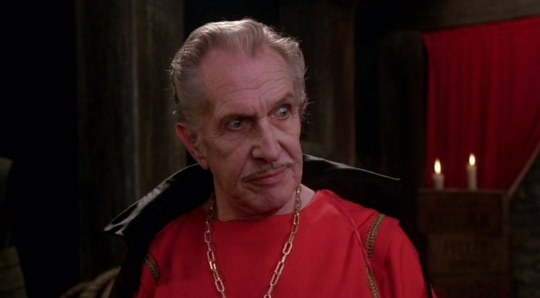
This…is not a very good movie. XD “Bloodbath at the House of Death” is a 1984 film that essentially attempted to do a non-musical version of what things like “Rocky Horror Picture Show” tried out. The film is a satirical, farcical comedy with a surreal and perverse sense of humor, which takes various horror and sci-fi tropes, then mixes and mangles them all with a combination of slapstick, over-the-top camp antics, and a heavy dose of vulgarity. However, while “Rocky Horror,” in my opinion, is successful in its attempts to both mock and pay homage to the genre and its cliches, “Bloodbath” is much less competent. To be blunt, it’s just not very funny. However, the movie is not completely without its merits…and most of those merits come from Vincent Price as the main villain of the story: a mysterious figure known simply as The Sinister Man. This wicked and wily antagonist is the leader of a Satanic cult. Years ago before the start of the film, this cult committed a massacre in the titular House of Death, and they now guard the property in secret, using it as a headquarters for their bizarre rituals. When a team of scientists go to the aged manor, investigating strange radiation readings emanating from the property, the Sinister Man bands his forces together to purge the outsiders from their lair. This is one of many times in Vincent’s career – particularly common in his later years – where he essentially is performing a work of self-parody. In fact, this was a fairly common thing with a lot of horror actors from years past, including Vincent’s friends, Christopher Lee and Peter Cushing, not to mention even older performers, such as Boris Karloff and Bela Lugosi. However, I would argue the difference between some other performers and Vincent’s way of working was that, even during his prime, Vincent ALWAYS had a sense of humor about himself and the reputation he had. As time went on, as a result, he was more than happy to joke about in such projects; it always felt so honest with Price. As if he was laughing right alongside the audience, happily guiding them through the mayhem. It’s this sparky sort of humor that makes Price’s turn as the Sinister Man genuinely great to watch. He makes the worst jokes suddenly snicker-worthy, and the few jokes that were already good suddenly become HILARIOUS in his skillful hands. He plays the Sinister Man with a sort of foppish silliness, as if he’s actively TRYING to be this all-powerful figure of grand oratory and awe, but his pomposity is constantly punctured, causing him to revert to a spoiled brat. It’s like if Daffy Duck decided to play…well…Vincent Price! And that’s a lot of fun to watch. A lot of my favorite comedic moments in Vincent’s career actually come from this one movie; therefore, even though the picture as a whole isn’t very good, I still felt it was worth giving it attention on the countdown.
Tomorrow, the countdown continues with my pick for Number 29!
#list#countdown#best#favorites#top 31 vincent price performances#the price may be right#number 30#vincent price#movies#film#horror#comedy#actors#acting#bloodbath at the house of death#sinister man
5 notes
·
View notes
Text

Tooning In 17 Douglas Booth part 2 of 7
DL:Yeah! So can you tell me a little bit about Glenn Leopard like you did with Jeffrey Scott?
DB:Leopard? Hahaha! Leopold! We had fun writing scripts together - I'd never worked with a writing partner before, but we would just tell each other stories and do our bad voice-actor impressions of the characters - and keep going - telling each other which ideas we liked and which we thought were terrible, trying to make each other laugh - and then writing it down - taking turns with that - and coming up with what we would usually feel was a brilliant script! Glenn had been a rock 'n roller prior to coming to H-B - his band was called "Gun Hill Road" (after a street in the Bronx) - and they had a nice run before he moved over to cartoons! He was very quick with ideas, jokes, and irrelevant asides, and we both got very good at throwing pushpins across the length of the office, to stick in our bulletin board - which may have been our most notable achievement!
DL:Leopard,I was thinking of Leopold! With his last name, who can't make a mistake like that?
DB:But of course! Leopold the Leopard - could have been an H-B cartoon!
DL:Haha! i know right! He was pure HB material as he stayed with the company until 2001! A true company man he was.
DB:Absolutely! His wife, as I remember, was the head of the ink and paint department, as well.
DL:Wow! Really?
DB:Yup! Nice lady!
DL:Any stories on the two?
DB:Not that I remember, though I'm sure there are many!
DL:Well after he left Hanna Barbera, he started to write for a German company called BKN, you probably worked with them right? P.S. they're also known by Bohbot Entertainment.
DB:Hmmm... not sure. I believe I worked on shows that Allen Bohbot, the founder, was involved with, maybe through DIC (?) - but, in terms of the European spin-off, when I just googled all that, none of the shows they produced looked familiar - though I would have loved to have worked on a new version of Zorro!
DL:Yeah Glenn worked on it, you could’ve too!
DB:All they had to do was ask!
DL:If you were around in 2006. Besides, Glenn was one of your friends.
DB:Who knows? There are probably thousands of shows that "slipped through my fingers" - but I certainly enjoyed working on the ones that didn't!
DL:Yeah well back to your career, The Flintstones Comedy Show for NBC. You were the story editor.
DB:As I remember, I story-edited episodes of "The Bedrock Cops", which was one element of that show.
DL:Explain to me the concept of the segment.
DB:Hahaha! Fred and Barney were cops - sort of "Car 54, Where Are You" goofy law enforcement officials, only in prehistoric Bedrock - with fun and silly adventures - nothing approaching "real crime", but lots of slapstick comedy and fun.
DL:oh, well when i think of Fred and Barney I don't really think cops but ok.
DB:No - but it was essentially the two buddies having the kind of funny adventures you'd imagine they'd have... that is, if they were, in fact, good-natured cops!
DL:Oh so why in 1980, did you Hanna Barbera the first time?
DB:? I think you missed a word or two…
DL:Why and left.
DB:At the end of 1980, I took my two week vacation and flew to Cusco, Peru - then took the train to "Kilometer 88" which was the jumping off point for a 5 day backpacking hike in the mountains, ending up at Mac. oops - Machu Picchu - which was really, really fun! However, when I got back to the U.S., I only then found out that Andy Heyward and I were both "budget cuts" in the writing department - and were thus free to pursue our diverse destinies! I guess things were slow and they decided they needed to economize!
DL:Wow! So they favor Glenn and Jeff over you two,huh?
DB:Can you imagine? No accounting for taste! 🙂
DL:I can, so how was finding work while Andy was on his own odyssey in 1981
DB:I got to broaden my horizons! I gained a lot of experience and knowledge from my time at HB and got to reach out to other studios, etc. As I remember, my next major gig was at Filmation, working on HeMan and the Masters of the Universe, as well as doing some development work for them that never quite made it to the air.
DL:well on IMDb after The Flintstones Comedy Show, you worked on Spider Man for Marvel Productions and NBC.
DB:Right - not sure of the timing for all this. I did write an episode of one of the versions of Spider-Man (and, years later, for another version of that show) - this first one was the version that Dennis Marks story-edited, and was, I think, my only professional encounter with Stan Lee. As well as the plate glass coffee table in their lobby that I always managed to bang into when I was walking past!
DL:Lol, that's awesome. Can you tell me about that encounter with the "business man" Lee?
DB:All I remember is that he was very friendly and nice - I think Dennis was mainly running the meeting, but I did think it was cool that Stan was sitting in on it, "supervising"!
DL:Lol! Wait Dennis is from Hanna Barbera too!
DB:Yes - that's where I knew him from.
DL:Any stories on him?
DB:Not that I can think of. At HB I knew him as a comedy writer, so it was a surprise to find him running the Spider-Man show - but I think he and Stan really hit it off and collaborated on a number of projects (none of which I know anything about - lol)!
DL:He stayed at Marvel, until 1986 when he returned to the studio.
DB:Ah!
DL:so, if you can remember, would you like to talk about an episode of the 1981 Spider man series?
DB:Well - not much that I remember. Believe I wrote one episode, called "The Vulture has Landed" - featuring a superhero named... you guessed it - "The Vulture". Apart from being happy to be working on Spider-Man, that's about all I can remember! That and the plate glass coffee table banging my shins every time I went into the studio!
(Actually the comic book character, The Vulture is a villain not a superhero.)
DL:That gotta hurt!
DB:That's why I remember it so well!
DL:Your return to Hanna Barbera in 1982?
DB:I worked as a freelancer on a few different shows - not on staff.
DL:Oh! understand. How did it feel sending scripts to your former co-workers?
DB:Fine! That's pretty much the same way it worked in-house - the only difference is that my office was off-premises (with better access to a refrigerator)! We're all pretty much co-workers, as writers, with people changing roles and studios, but, many times, working with a familiar array of "the usual suspects".
DL:Oh! Wow!
DB:Although, of course, a lot more time needs to be spent "hustling" when one is working freelance!
DL:So about Spider Man, how do you write the web crawler?
DB:Well, we all know what he's like and what he does - at that point, from the comics - so the idea would be to start imagining oneself as Spidey and working to craft an adventure that would work for him, and then see how he would respond!
DL:Yeah, I mean everyone knows Spider Man right? So, you wrote an episode of The Little Rascals animated series. Rascal’s Revenge, process for the episode?
DB:Hahaha! I know I did - and I did like the original Little Rascals, back when I was a "little rascal" myself - but I don't remember anything about that episode at the moment!
DL:Oh ok, so did you watch the original shorts on television?
DB:Yes!
DL:You wrote the episode with Tedd Anatsi and Patsy Cameron. Who are those two?
DB:Hmmm. They were a writing team - maybe husband and wife? And... maybe they were the story-editors?
DL:Ah ok, do you have any memory of writing with them?
DB:No, I don't believe we co-wrote it - but, er, who knows? If that's what it says on IMDB, well, I believe it's incorrect - unless, say, either they had written the story and I was asked to write the script - or vice versa?
DL:Yeah probably fixed your script as story editors. Yeah probably fixed your script as story editors.
DB:Makes sense - though "fixed" depends upon the eye of the beholder - hahahaha!
DL:Haha! How was trying to make old 30s comedy shorts to appeal to 80s kids?
DB:Well, they certainly appealed to "50's kids" - so not too hard! A fun gang comedy - and the new version would have come with a bible, which would have done most of the heavy lifting for the transposition from the 30's to the 80's - so that's where the foundation would come from - and, from there - it would be "just like any other show" - where you read the bible and any scripts that are available, as well as remembering the feeling of fun from the originals - all of which would then allow you to start to "think like a Little Rascal" and start brainstorming stories and character action, while hanging out with "the gang" in your imagination and seeing what popped up!
DL:Very interesting! So The Smurfs for NBC and SEPP International.
DB:I think IMDB gave me too much credit for that show - as I remember, I wrote an episode for Smurfs and several for Johann and Peewee - which featured the Smurfs. I think Len Janson and Chuck Menville were the story-editors for The Smurfs, and Glenn Leopold was story-editor for Johann and Peewee, which I think were based on illustrated books by Peyo, the original creator.
DL:IMDb said that you wrote 39 episodes of the show in 1982!
DB:Whoa! Yeah, simply not true! Gasp - you mean IMDB isn't infallible? Oh well - mostly they're pretty good!
DL:Yeah, I know! Okay! So Monchichis for ABC, what was that?
DB:Hmmm. Bryce Malek and Dick Robbins were the story-editors. Fun, woodland fantasy creatures - I suspect there was a major comedic villain who wanted to do terrible things to them - and they had to figure out fun and imaginative ways to foil these nefarious plots! I know I wrote two episodes - and enjoyed doing it. One was called "Sky City'' - I think - which seems self-explanatory - but which is also a sort of a nod to the Native American city of Acoma (in New Mexico) - which also goes by the nickname of "Sky City", and is a cool place I've visited on several occasions. Bryce had been the guy in the accounting department at HB who used to walk around and give us our checks, but he was also a writer, and, as he was writing spec scripts, I seem to remember that Glenn and I used to give him notes! And then, he partnered with Dick Robbins, who was a veteran writer - and they became a great team - and, of course, went on to become the story-editors of the first couple of seasons of Transformers! Apart from all that, sorry, I don't remember much more about Monchichis - just that it was a good-natured and light-hearted fantasy/action/comedy that was fun to write.
DL:Ok. Well time for He Man! and you are working for Filmation.
DB:Right!
DL:He Man for Filmation and Syndication/Group W
DB:I was on staff there for a bit - my office was actually the coffee room - so I got to see most of the people on the floor!
DL:How was Lou Scheimer? The head honcho?
DB:I didn't have much contact with him - just "hi, how are you?" - the person who was in charge of the writers was Arthur Nadel.
DL:Tell me about Arthur Nadel. Robby London said he was a great guy.
DB:Yes, he was! Deadpan, but funny. He had a series of initials he'd use, to make comments on your script - like NSG (not so good) - DB (do better) - not sure what other ones, but there were a good many! The best moment I had in his office was when he was raking me over the coals for an outline which he thought was terrible - not letting me get a word in edgewise - until he was finished, and I (grinning broadly) - told him that I was not the writer of that episode! He thought that was pretty funny, as well!
DL:Once I remember he gave Robby London an A, and Robby thought it was a grade and Arthur had to break it to him saying it was just his signature. That he wrote that A to show that he read it.
DBThat's hilarious - and sounds totally in character!
#animation#animation interview#tooning in.#80s cartoons#the smurfs#he man#filmation#hanna barbera#spider man#marvel productions#monchhichi#monchhichis#the little rascals#the flintstones
1 note
·
View note
Text

Prompt: generate a movie concept about a comedian famous for his quirky style of humour. That style is entirely due to the fact that when he makes a joke deemed bad, his skin turns a garish color… but who- or whatever decides what counts as a "bad joke" has mildly incomprehensible tastes.
Title: The Crimson Comedian
Tagline: He'll make you see red.
Logline: Max Zevon, a rising star comedian with a unique problem: bad jokes turn him a horrifying shade of crimson. His quest for comedic success becomes a hilarious and terrifying tightrope walk, as he navigates the whims of an unseen entity that dictates "funny."
Characters:
Max Zevon: A charming and ambitious comedian whose career hinges on avoiding the dreaded "Crimson Curse." He develops an eccentric and unpredictable style to appease the unknown judge of humor.
Chloe Carter: A witty and supportive writer for Max, helping him craft jokes that walk the line between funny and "crimson."
Roger "The Guru" Gandhi: A washed-up comedian turned conspiracy theorist, convinced Max's success is due to a secret society of humor enforcers. (Comic Relief)
Plot:
Max Zevon is taking the comedy scene by storm. His act is a bizarre blend of observational humor, slapstick, and nonsensical puns. What the audience doesn't know is Max suffers from a peculiar affliction - whenever he tells a bad joke, his skin erupts in a horrifying shade of crimson. This "Crimson Curse" is a constant threat, fueled by an unseen entity Max dubs "The Fun Master."
Living in Fear of Red:
Max relies on Chloe, his sharp-witted writer, to craft jokes that teeter on the edge of funny without triggering the Curse. Their brainstorming sessions are a hilarious mix of creativity and paranoia. Max avoids stand-up routines with open mics, fearing the unpredictable nature of crowd reactions.
The Guru and the Conspiracy:
Enter Roger "The Guru" Gandhi, a washed-up comedian convinced Max's success is due to a secret society called "The Humorless Men." Max initially dismisses him, but Roger's outlandish theories sometimes offer surprisingly insightful observations about the nature of humor.
The Stakes Rise:
As Max's fame grows, so does the pressure. Network executives push him for broader, more mainstream humor, unknowingly pushing him closer to the Crimson Curse. A viral video of Max accidentally turning crimson during a live show threatens to derail his career.
Facing the Fear of Funny:
Desperate to regain control, Max and Chloe embark on a journey to understand The Fun Master. They delve into forgotten comedy archives, interview eccentric humor scholars, and even consult a hypnotist (with disastrous results). Through their quest, Max starts to question the very nature of humor and its subjective nature.
Climax and Resolution:
In a hilarious and suspenseful climax, Max finds himself in a high-stakes situation - a comedy competition where he must win over a notoriously critical audience. With Chloe by his side and a newfound understanding of humor, Max decides to embrace the unpredictable, telling jokes that are genuinely funny to him, regardless of the consequences.
Ending:
The movie ends with Max delivering his final routine, a hilarious blend of his trademark quirky style and genuine comedic observations. The audience erupts in laughter, and Max remains a normal, non-crimson color. A final beat shows a shadowy figure in a darkened room, chuckling at a screen displaying Max's performance. Did The Fun Master approve, or was it just a lucky night? The answer, like humor itself, remains open to interpretation.
#ai generated#stupid ideas#shitpost#imaginary movie#google gemini#movie poster#poster#genre: drama#genre: comedy#comedian#comedy#absurdity#magical powers#genre: magical realism#show business
0 notes